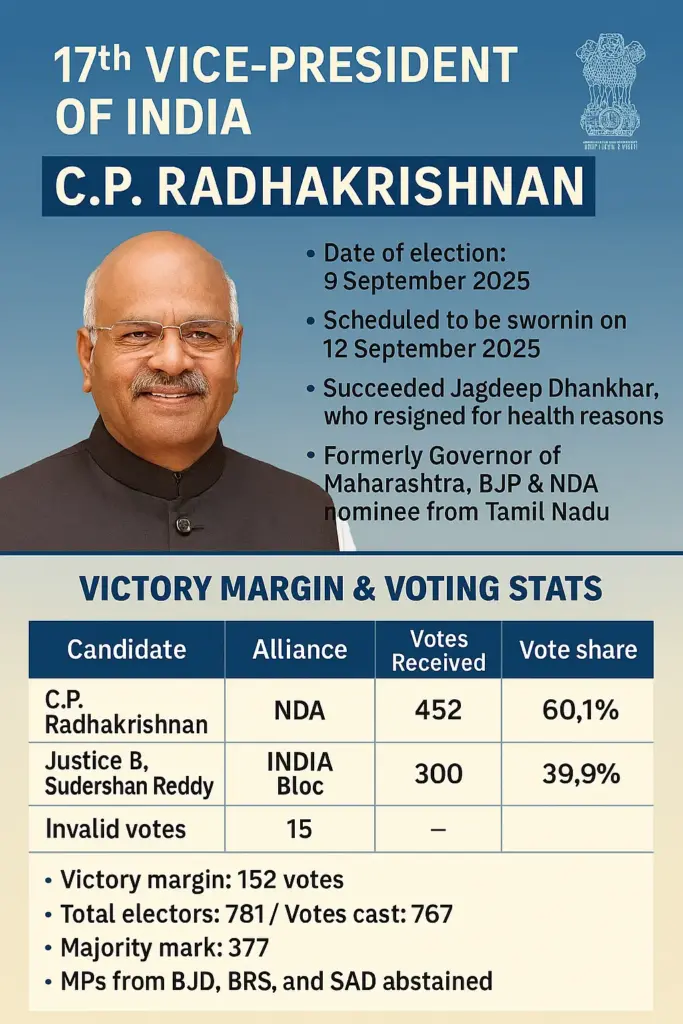September 10, 2025
17th Vice-President of India: C.P. Radhakrishnan
C.P. Radhakrishnan, the Governor of Maharashtra, has been chosen as the 17th Vice President of India.
- He secured 452 first preferential votes, defeating the Opposition’s joint candidate Justice B. Sudershan Reddy, who got 300 votes.
- The margin of victory was 152 votes.
- About 98.2% of the electoral college, including members from both Houses of Parliament, took part.
- A total of 14 members refrained from casting their vote, while 15 ballots were deemed invalid.
Key Points from the Election:
Total Electoral College Strength: 788 (Rajya Sabha 245 + Lok Sabha 543).
Present Strength on Voting Day: 781 (Rajya Sabha 239 + Lok Sabha 542).
Votes Polled: 767 valid votes.
Result:
- C.P. Radhakrishnan (NDA) – 452 votes.
- B. Sudershan Reddy (Opposition) – 300 votes.
Cross Voting: NDA managed to gain at least 13 extra votes from the Opposition camp.
PM Narendra Modi’s Congratulatory Message: He praised Radhakrishnan’s lifelong work for society and empowerment of the marginalized.

Procedure of Election of the Vice-President:
The process for electing India’s Vice-President is detailed in Article 66 of the Constitution.
Electoral College:
- Members from both Houses of Parliament, namely the Lok Sabha and the Rajya Sabha.
- Nominated members of both Houses also participate, unlike in the Presidential election.
Voting System:
- Single transferable vote system.
- Voting is done by secret ballot.
- MPs rank candidates in order of preference.
Returning Officer:
- The Returning Officer’s role in the Rajya Sabha is performed by the Secretary-General.
Eligibility Criteria (Article 66(3)):
- Must be an Indian citizen.
- Minimum age: 35 years.
- Should possess the eligibility required for election to the Rajya Sabha.
- They are not permitted to occupy any office of profit under either the Central or State Government.
About Vice-President of India :
In India, the Vice-President holds the second-highest position in the constitutional hierarchy, after the President.The provisions related to this office are enshrined in Articles 63 to 71 of the Indian Constitution.
Article 63 – Office of Vice-President:
“There shall be a Vice-President of India.”
- The Constitution requires establishing the position of Vice-President.
- It is a permanent constitutional position, similar to the office of the President.
Article 64 – The Vice-President serves as the ex-officio Chairperson of the Rajya Sabha.
The Vice-President serves as the ex-officio Chairperson of the Rajya Sabha and is prohibited from holding any other office that yields profit.
- The Vice-President mainly serves as the Chairman of the Rajya Sabha, functioning in a role comparable to the Speaker of the Lok Sabha.
- Not allowed to occupy any position that generates personal profit, ensuring independence and impartiality.
Article 65 – Vice-President to Act as President:
- In the event of:
- In the event of the President’s death, resignation, removal, or inability to perform duties, the Vice-President assumes the role of President of India until a new President is elected or the incumbent returns to office.
- The Vice-President does not automatically become President, unlike the U.S. model.
- Can serve as President for up to six months, during which a new election must take place.
Article 66 – Election of Vice-President:
The procedure of election is laid down under this Article.
Key provisions:
Electoral College:
- Representatives from the Lok Sabha and the Rajya Sabha.
- Nominated members also participate, unlike in the Presidential election.
Voting System:
- Representation based on proportionality using a single transferable vote system.
- A secret ballot is used.
Eligibility Criteria:
- Must be a citizen of India.
- Minimum age: 35 years.
- Must fulfill the eligibility requirements to serve as a Rajya Sabha member.
- Cannot hold any office of profit under:
- Government of India,
- State Government, or
- Any local authority controlled by the Government.
Article 67 – Term of Office:
- Duration: Five years starting from the assumption of office.
- Resignation: Can resign by writing to the President.
- Removal:
- It can be repealed through a Rajya Sabha resolution approved by a majority of its members and subsequently accepted by the Lok Sabha.
- A notice period of 14 days is required prior to passing such a resolution.
Article 68 – Time of Holding Elections:
- Elections to fill a vacancy must be completed before the expiry of the term.
- If a position becomes vacant due to death, resignation, or removal, a new election should be conducted at the earliest opportunity.
Article 69 – Oath or Affirmation:
- The Vice-President must take an oath or make a formal affirmation prior to taking office.
- Oath is administered by the President of India.
Article 70 – Performing the President’s Duties in Other Situations
- Parliament may make laws to determine who will discharge the functions of the President, if both the offices of President and Vice-President fall vacant simultaneously.
Article 71 – Issues Related to Elections or Their Proceedings
- The Supreme Court has the final authority to adjudicate disputes related to:
- The election of the Vice-President, or
- Any matter connected with such elections.
History of the Vice-President of India:
The post was created in 1952, similar to the U.S. model but with a few differences.
| Vice-President | Term | Notable Facts |
|---|---|---|
| Dr. S. Radhakrishnan | 1952–1962 | 1st VP, later President |
| Dr. Zakir Husain | 1962–1967 | Became President later |
| V.V. Giri | 1967–1969 | Resigned to contest Presidential elections |
| B.D. Jatti | 1974–1979 | Acting President for a period |
| Hamid Ansari | 2007–2017 | Served two consecutive terms |
| M. Venkaiah Naidu | 2017–2022 | Former Union Minister |
| Jagdeep Dhankhar | 2022–2025 | Immediate predecessor |
| C.P. Radhakrishnan | 2025–present | 17th Vice-President |
September 17, 2025
September 16, 2025
September 15, 2025
September 9, 2025
